ARDOUR
- INTRODUCTION
- INSTALLATION OS X
- INSTALLATION LINUX
- GETTING STARTED
- STARTING SESSIONS
- EDITING SESSIONS
- MIXING SESSIONS
- EXPORTING SESSIONS
- SAVING SESSIONS
- APPENDICES
Ardour looks for VST plugins in the location (s) indicated by your environment variable VSTPLUGINS. If that is not set, it will use VSTPATH. If neither are set it will look in /usr/local/lib/vst and /usr/lib/vst (on x8664 and OS X, some additional directories will be searched, following conventions on thos platforms). The Plugin Manager window. Plugin Display Status. Click on a Fav(orite) or Hide radio button to change a plugin's display status. Clicking on an already selected radio button will cancel it, returning the plugin to the normal display status. Plugins marked as a favorite show up in the Processor Box context menu under New Plugin Favorites. The Plugin Manager window. Plugin Display Status. Click on a Fav(orite) or Hide radio button to change a plugin's display status. Clicking on an already selected radio button will cancel it, returning the plugin to the normal display status. Plugins marked as a favorite show up in the Processor Box context menu under New Plugin Favorites.
Plugins can be used to enhance or transform the sound of individual Tracks via a Track Plugin, or groups of Track via a Send. Later in this FLOSS Manual, we will discuss some Plugins specific to the Mixing process, such as Compressors, Limiters, Parametric Equalizers, Reverbs and others.
Plugin Formats
LADSPA (Linux Audio Developers Simple Plugin API)
LADSPA Plugins are the 'native' Plugin format for Ardour. They were initially developed for Linux, but since have been ported to OS X as well.
LV2
LV2 is a simple but extensible successor of LADSPA, which can be used to display sound characteristics in a graphical manner. LV2 Plugins can be used on OS X and Linux.
AU (Audio Unit)
AU Plugins are the 'native' Plugin format for OS X. They will only work in Ardour if you have made a donation when you downloaded the program. See the Installing OS X chapter for details. AU Plugins will not work on Linux at all.
Ardour 3 Vst Plugins Vst
VST (Virtual Studio Technology)
VST Plugins are a Plugin format common to Microsoft Windows. Some VST Plugins can be used on Linux, however they may not function correctly, or even cause Ardour to crash. Using these Plugins requires manually Compiling the Ardour application, a task which is outside the scope of this manual.
More information about using LADSPA, LV2 and VST plugins with Ardour, you can find here:http://ardour.org/plugins
Pre-Fader vs Post-Fader
You have a choice whether you would like to add your Plugin to the Pre-Fader Plugin Region or the Post-Fader Plugin Region. The black region at the top of the far-left Mixer Strip functions as Pre-Fader, and the black area at the bottom of the Mixer Strip is used as Post-Fader. Pre-Fader Plugins are inserted in the signal path before the Fader, so that the Fader controls the level of the signal coming out of the Plugin. Post-Fader Plugins are inserted after the Fader: the Fader controls the level of the signal going into the Plugin. For some Plugins, Pre- or Post-fader placement does not matter. For others, the difference is subtle. For others still, inserting them in the right place is absolutely essential.
Adding a Plugin to a Track or Bus
Select the Track or Bus to which you want to add the Plugin.
Right-click in the area you want to use, and click New Plugin > Plugin Manager to open the Plugin Window (you can also access the Plugin window by double-clicking in the black region).
All available Plugins are listed at the top of the Plugin Window. Choose one by double-clicking it, or select it and press the Add button. The selected Plugin is listed in the black region at the bottom of the Plugin window. Select all the Plugins you want to add.
You can search for a Plugin by typing in the name or type of effect wanted. In this example, we look for a Reverb effect.
Insert the Plugins in the track by pressing the Insert Plugin(s) button. The Plugins are listed in the black area above the Mixer Strip.

Editing and Saving Plugin Parameters
Double-click a Plugin to edit its parameters. In this example, we change the pitch shift or the buffer size.
Click the Save button to save the preset under a new name.
Bypassing Plugins
To bypass the Plugin, press the Bypass button. This turns the Plugin off and allows the signal to pass by it unaffected.
Bypassed Plugins are shown with parenthesis on the Mixer Strip.
Right-Clicking the Plugins will give a menu with the option to Activate and Deactivate them.
Continuing
In this chapter, we learned how to add a Plugin to a single Track. This is useful if that Track needs a specific Plugin, but if you have a Plugin which is used for many Tracks at the same time, you should continue to the next chapter about Using Sends. You can also continue to the various, Plugin-specific chapters such as Dynamics and Equalizing.
This is a tutorial on how to add, install and use plugins in Ardour using Linux. Plugins are highly valuable anytime you do audio mixing and mastering work. Example of plugins can be reverb, EQ, compressors, etc.
Install Ardour first
This is tested to work in Ubuntu Lucid Lynx and Ardour 2.8.6. If you still have not installed Ardour, then follow the steps below:
1.) First, make sure your Ubuntu distribution is updated. In Ubuntu, go to System – Administration – Update manager, make sure it says “Your system is up to date”.
2.) Install “jackd” first, these are low latency audio tools very useful for recording. Go to System—Administration–Synaptic Package Manager. In the newly released distribution of Linux, it does not anymore include Synaptic Manager. But there should be a tool for managing installed software. For example in Ubuntu, this is called Ubuntu Software manager.
Login using your root Linux password. Under quick search, type jackd

3.) Check “jackd” and then click “mark for installation” , there are other dependent packages to be installed so just click “Mark” as well. To install these packages, click “Apply” in the Synaptic package manager menu. If it ask “Apply the following changes”? Click Apply.

4.) If it ask enable jackd for realtime process priority? Check yes and click “Forward”. After installation it will be marked with green marks beside them. Make sure jackd, jackd-firewire, and qjackctl are green marks.
In the modern installation of Ardour particularly with the latest Ubuntu distributions, it will automatically configure for real time implementation of Jack. You simply need to press “Forward” to install.
But you can always confirm by going to Places—Computer—File System–etc–security–limits.d. Make sure there is a file there called “audio.conf” with the contents below:
@audio – rtprio 99
@audio – memlock unlimited
#@audio – nice -19
5.) You need to confirm that you have added your username to the @audio group. Go to System—Administration—Click “Manage Groups”. Click “audio” group under “Group settings”, then click “Properties”. Under “Group members”, check your Ubuntu username and click OK. Verify by entering your root Linux password. Then close all windows.
6.) Logout to your username and login again (not restart or reboot just click Logout).
7.) After logging back in, Go to Applications – Ubuntu Software – and in the search box , type “Ardour”. When you see “Ardour GTK2”, click “Install” then proceed by entering your Linux password to authenticate.
Ardour in Ubuntu software
8.) Try starting Jack first before starting Ardour. It is because Ardour depends on JACK. Enter the command in the terminal: qjackctl. For details, read this tutorial:
And then go to Step 4.c. There is a procedure there on how to start Jack without Xruns.
9.) After installation, launch Ardour by going to Applications –Sound and Video– Ardour GTK2.
10.) Finally click “Start”. You are then ask to start a new session. Select “new session” tab.Type the name of the sesssion example, “sessiontest” . Then for convenience I saved the files to my Ubuntu desktop. Click “New”.
11.) The nice-looking Ardour digital audio workstation environment will then load up, ready to accept tracks for you to record, mix or even master.